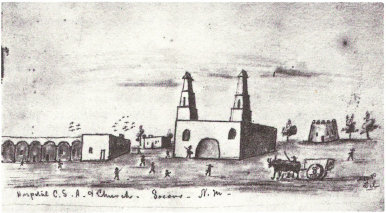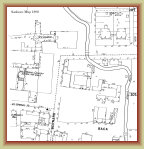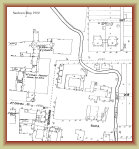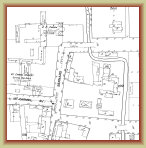Socorro County Historical Society
Socorro, New Mexico, USA
San Miguel Church
History
Articles
Most documentation on the early churches were recorded by the Franciscan friars, with a fairly detailed report by Bishop Benavidez in 1626 being an excellent reference. Most other documents were often sketchy with period of years between reports, such that the early history of most mission churches, including San Miguel, is well known in places and assumed in others.
The following is the assumed San Miguel Church timeline based on known documentation, assumed history, and church traditions.
1598 Juan de Oñate arrives at Teypana pueblo; people rename it to
Socorro for the help and assistance received. This was the first
Socorro. Today's Socorro was the Pilabó pueblo, though not
visited by Onate during the Entrada.
1600s Franciscan friars, most from Isleta pueblo, visited the Piro pueblos
periodically for the Christianization effort and conducting mass.
1615 Congregation formed. According to church
history, the first priest
was assigned to Pilabó (Socorro) to serve
the Piro. However, there
is no documentation or evidence
that a mission church or convento
was built until the mid-1620s.
If a priest was at Pilabó 1615-1626,
he lived and ministered
in existing pueblo quarters.
1620 Reducción, the Spanish resettlement program, consolidated the
native population into fewer pueblos for better control; selected
Sevilleta (La Joya), Pilabó (Socorro) and Senecú (San Marcial) as
the
mission pueblos of the Piro nation. All other pueblos were
ordered abandoned;
people from Teypana relocated to Pilabó,
bringing the name Socorro
with them. Construction of the
mission in Pilabo (today's
Socorro) likely began around this time.
1626 Bishop Alonso de Benevidez returns to Mexico City along El
Camino Real enroute to Spain. Dedicated the mission while in
Socorro, naming it Nuestra Señora del Socorro (Our Lady of
Perpetual
Help). It is assumed the Socorro mission's construction
was fairly
underway, if not completed, when dedicated in 1626.
1630-80 Pueblo of Socorro (Pilabó) and the church continued to grow.
1680 The Pueblo Revolt forced the Spaniards out of New Mexico,
retreating south
to El Paso on the Rio Grande. The Piros fled with
the Spaniards leaving
Socorro and the church abandoned.
1692 Don Diego de Vargas reoccupies New Mexico, camping the
night in Socorro and described the pueblo and church as "in ruins."
1760 Bishop Tamarón arrives New Mexico, camps
on hill opposite
Socorro. Records he could see the old orchards
of Socorro and
ruins of the mission.
Settlement between Belen and Doña Ana was prohibited after the Pueblo Revolt as Spain could not protect the region,
called Apacheria, from
Indian attacks. Socorro remained abandoned until resettlement in 1800.
1800 Resettlement of
Socorro approved; first families arrived
1800-1806 to settle and rebuild
the town. Rebuilding the old
ruined church began during
this time -- exact date unknown.
San Miguel Church. Tradition states early townspeople took refuge in
the
church during an Apache raid. An apparition of archangel Michael weilding a sword protected the people and drove off the attacking
Indians. The Nuestra Señora del Socorro church was renamed San Miguel in
honor of Saint Michael's protection of
the church.
1851 San Miguel visited by Bishop Lamy enroute to Santa Fe.
1864 Fr. Benedict Bernard welcomes Bishop Lamy to San Miguel
parish.
1869 Renovation added
the two bell towers (per church history).
NOTE: the diary sketch
of the church by Confederate soldier Pvt.
A. B. Peticolas clearly
shows the "French style" bell towers were
extant in 1862.
1870s The
pitched roof and the front stained glass window were added.
1879 Sisters of Loretto arrived to build a parish
school building, which
served Socorro until 1970. The north side chapel was added and
other renovations were performed about
this time.
1880s Today's facade was added, bell towers replaced with the territorial
style, followed by further renovations to the church.
1973 Extensive renovation to San Miguel interior
with new woodwork
and vigas, spiral stair case to choir loft and strengthening
adobe
walls. Evidence of original church found by archaeolists,
including
original mission wall, foundations, burned vigas when church
was
burned in 1680, and skeletons and graves under floor boards.
2003
Courtyard built in front of church to honor the many parishoners
buriedin the ancient camposanto; grave markers and cross added
later.
2010 Church closed. Structural problems (mostly within the adobe
load bearing walls, roof, and bell towers) close the church
pending
major repairs; services moved to Parish Hall. Extensive
repairs,
renovation, and preservation of the historic integrity of
the church continued
until 2015 under direction of parish priest,
Fr. Andrew Pavlik.
2015 San Miguel Church reopens and rededicated after five years
of extensiverepairs, and just in time for . . .
2015 400th Anniversary of the Socorro mission church with the
original congregation formed in 1615 and the original Nuestra
Señora
del Socorro mission church built shortly after that,
dedicated in
1626.

Oldest known image of Socorro's San Miguel Church
drawn by Confederate soldier Albert Peticolas on Feb. 26, 1864 while passing through
Socorro after the Battle of Valverde.
Sketch shows the original flat roof and "French style" towers. Pitch roof was added early
1870s; today's bell towers were built 1880s.


Click here for
San Miguel Book of the
Solemn Rededication on May 19, 1974.
Book was published following extensive renovation
1972-1974 with church history, photos of the renovation and archaeological findings, and area mission churches.

> Historic photos of the church
> Present day photos of the church
> Photos
of the 2010-2015 repairs



Sanborn Insurance Maps
showing San Miguel church, Mt. Carmel Convent, acequia Madre, and other surrounding features over
the years.
Click maps to enlarge
1898
1902
1913
Mission Church History
History articles by Paul Harden on the mission churches under the Socorro Parish and related church history.
church (Riley), and Our
Lady of Fatima church (Florida)
Polvadera, Lemitar, Sabino, La Parida, El Tajo,
Bosquecito, Luis Lopez, San Antonio, San Antonito,
San Marcial, La Plaza Vieja, Magdalena,
Kelly
Franciscan nun in
the 1600s - including in Socorro.
traditional
pagents to tell the Christmas story.
building of the La Sagrada Family Church.
and the San Lorenzo church.
On this page:
SAN MIGUEL HISTORY & TIMELINE
Links:
19/05A






